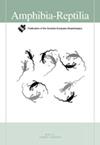性别、大小和生态地理因素影响了伊比利亚蝰蛇的摄食生态
IF 1.3
4区 生物学
Q3 ZOOLOGY
引用次数: 2
摘要
大量的饮食研究表明,欧洲蝰蛇(Vipera属)的进食频率较低,饮食也很专业,其特征是个体遗传发生了显著变化。然而,生态地理因素如何塑造物种的觅食生态却很少被提及。我们调查了伊比利亚蝰蛇Vipera seoanei的觅食生态学,检查了分布在其分布范围内的402个标本,并探讨了生物、时间和生态地理因素与物种觅食活动和饮食消耗的关系。我们的研究结果表明,该物种的进食频率较低,幼鱼的进食频率高于成年鱼。成年雌性的猎物消耗率高于成年雄性,这符合两性不同的生殖需求,尽管生殖雌性和非生殖雌性之间没有差异。seoanei捕食各种分类群,但以小型哺乳动物为基础,表现出相当专业的饮食。两栖动物和爬行动物也是其饮食的重要组成部分,尤其是幼年动物。体型被发现是与主要猎物群体的消费相关的单一生物学特征,支持饮食中个体遗传变化的发生。两个栖息地和两个气候因素与主要猎物群体的消费相关,反映了整个毒蛇范围内猎物的生态需求。总的来说,这项研究扩展了欧洲毒蛇喂养生态学的现有知识,表明能量摄入和异速限制如何影响该物种的喂养活动和饮食消耗,从而在幼年和成年中产生不同的喂养策略。本文章由计算机程序翻译,如有差异,请以英文原文为准。
Sex, size and eco-geographic factors affect the feeding ecology of the Iberian adder, Vipera seoanei
Numerous dietary studies have shown that European vipers (genus Vipera) present low feeding frequency and a specialist diet, which is characterised by a marked ontogenetic shift. However, how eco-geographic factors shape species’ feeding ecology remains scarcely addressed. We investigated the feeding ecology of the Iberian adder, Vipera seoanei, examining 402 specimens distributed across its distributional range and addressing how biological, temporal and eco-geographic factors relate to the species feeding activity and dietary consumption. Our results indicated a low feeding frequency in the species, higher in juveniles than in adults. Adult females showed higher rates of prey consumption than adult males, which match to the distinct reproductive demands of both sexes, although no differences between reproductive and non-reproductive females were found. V. seoanei preyed on a varied taxa spectrum, but showed a rather specialist diet based on small mammals. Amphibians and reptiles were also an important part of its diet, particularly in the juveniles. Body size was found as the single biological trait related to the consumption of major prey groups, supporting the occurrence of an ontogenetic shift in the diet. Two habitat and two climatic factors correlated to the consumption of major prey groups, reflecting the ecological requirements of prey across the viper’s range. Overall, this study extends the existing knowledge on the feeding ecology of European vipers, signalling how energy intake and allometric constraints shape the feeding activity and dietary consumption of the species across the geography, leading to distinct feeding strategies in juveniles and adults.
求助全文
通过发布文献求助,成功后即可免费获取论文全文。
去求助
来源期刊

Amphibia-Reptilia
生物-动物学
CiteScore
3.10
自引率
6.20%
发文量
39
审稿时长
6-12 weeks
期刊介绍:
Amphibia-Reptilia is a leading European multi-disciplinary journal devoted to most of the aspects of herpetology: ecology, behaviour, evolution, conservation, physiology, morphology, paleontology, genetics, and systematics.
Amphibia-Reptilia publishes high quality original papers, short-notes, reviews, book reviews and news of the Societas Europaea Herpetologica (SEH). The Societas Europaea Herpteologica (SEH) website is located at: www.seh-herpetology.org.
 求助内容:
求助内容: 应助结果提醒方式:
应助结果提醒方式:


